Shaodan Ma
Model-Driven Deep Learning Enhanced Joint Beamforming and Mode Switching for RDARS-Aided MIMO Systems
Aug 01, 2025Abstract:Reconfigurable distributed antenna and reflecting surface (RDARS) is a promising architecture for future sixth-generation (6G) wireless networks. In particular, the dynamic working mode configuration for the RDARS-aided system brings an extra selection gain compared to the existing reconfigurable intelligent surface (RIS)-aided system and distributed antenna system (DAS). In this paper, we consider the RDARS-aided downlink multiple-input multiple-output (MIMO) system and aim to maximize the weighted sum rate (WSR) by jointly optimizing the beamforming matrices at the based station (BS) and RDARS, as well as mode switching matrix at RDARS. The optimization problem is challenging to be solved due to the non-convex objective function and mixed integer binary constraint. To this end, a penalty term-based weight minimum mean square error (PWM) algorithm is proposed by integrating the majorization-minimization (MM) and weight minimum mean square error (WMMSE) methods. To further escape the local optimum point in the PWM algorithm, a model-driven DL method is integrated into this algorithm, where the key variables related to the convergence of PWM algorithm are trained to accelerate the convergence speed and improve the system performance. Simulation results are provided to show that the PWM-based beamforming network (PWM-BFNet) can reduce the number of iterations by half and achieve performance improvements of 26.53% and 103.2% at the scenarios of high total transmit power and a large number of RDARS transmit elements (TEs), respectively.
Out-of-Band Modality Synergy Based Multi-User Beam Prediction and Proactive BS Selection with Zero Pilot Overhead
Jun 18, 2025Abstract:Multi-user millimeter-wave communication relies on narrow beams and dense cell deployments to ensure reliable connectivity. However, tracking optimal beams for multiple mobile users across multiple base stations (BSs) results in significant signaling overhead. Recent works have explored the capability of out-of-band (OOB) modalities in obtaining spatial characteristics of wireless channels and reducing pilot overhead in single-BS single-user/multi-user systems. However, applying OOB modalities for multi-BS selection towards dense cell deployments leads to high coordination overhead, i.e, excessive computing overhead and high latency in data exchange. How to leverage OOB modalities to eliminate pilot overhead and achieve efficient multi-BS coordination in multi-BS systems remains largely unexplored. In this paper, we propose a novel OOB modality synergy (OMS) based mobility management scheme to realize multi-user beam prediction and proactive BS selection by synergizing two OOB modalities, i.e., vision and location. Specifically, mobile users are initially identified via spatial alignment of visual sensing and location feedback, and then tracked according to the temporal correlation in image sequence. Subsequently, a binary encoding map based gain and beam prediction network (BEM-GBPN) is designed to predict beamforming gains and optimal beams for mobile users at each BS, such that a central unit can control the BSs to perform user handoff and beam switching. Simulation results indicate that the proposed OMS-based mobility management scheme enhances beam prediction and BS selection accuracy and enables users to achieve 91% transmission rates of the optimal with zero pilot overhead and significantly improve multi-BS coordination efficiency compared to existing methods.
Wireless Communication for Low-Altitude Economy with UAV Swarm Enabled Two-Level Movable Antenna System
May 28, 2025Abstract:Unmanned aerial vehicle (UAV) is regarded as a key enabling platform for low-altitude economy, due to its advantages such as 3D maneuverability, flexible deployment, and LoS air-to-air/ground communication links. In particular, the intrinsic high mobility renders UAV especially suitable for operating as a movable antenna (MA) from the sky. In this paper, by exploiting the flexible mobility of UAV swarm and antenna position adjustment of MA, we propose a novel UAV swarm enabled two-level MA system, where UAVs not only individually deploy a local MA array, but also form a larger-scale MA system with their individual MA arrays via swarm coordination. We formulate a general optimization problem to maximize the minimum achievable rate over all ground UEs, by jointly optimizing the 3D UAV swarm placement positions, their individual MAs' positions, and receive beamforming for different UEs. We first consider the special case where each UAV has only one antenna, under different scenarios of one single UE, two UEs, and arbitrary number of UEs. In particular, for the two-UE case, we derive the optimal UAV swarm placement positions in closed-form that achieves IUI-free communication, where the UAV swarm forms a uniform sparse array (USA) satisfying collision avoidance constraint. While for the general case with arbitrary number of UEs, we propose an efficient alternating optimization algorithm to solve the formulated non-convex optimization problem. Then, we extend the results to the case where each UAV is equipped with multiple antennas. Numerical results verify that the proposed low-altitude UAV swarm enabled MA system significantly outperforms various benchmark schemes, thanks to the exploitation of two-level mobility to create more favorable channel conditions for multi-UE communications.
When Feedback Empowers the Uplink: Integrating Adaptive Coding with Wireless Power Transfer
May 28, 2025Abstract:Energy consumption and device lifetime are critical concerns for battery-constrained IoT devices. This paper introduces the Feedback-Aided Coding and Energy Transfer (FACET) framework, which synergistically combines adaptive feedback channel coding with wireless power transfer. FACET leverages the saturation effect of feedback coding, where increasing downlink power yields diminishing returns, to design a dual-purpose feedback mechanism that simultaneously guides uplink coding and replenishes device energy. We characterize the inherent tradeoff between feedback precision and harvested power, and formulate a fairness-constrained min-max optimization problem to minimize worst-case net energy consumption. An efficient algorithm based on alternating optimization and Lagrangian duality is developed, with each subproblem admitting a closed-form solution. Simulations show that FACET nearly triples device lifetime compared to conventional feedback coding architectures, and remains robust across a wide range of power regimes. These results suggest that FACET not only improves communication efficiency but also redefines the role of feedback in energy-constrained IoT systems.
Reconfigurable Codebook-Based Beamforming for RDARS-Aided mmWave MU-MIMO Systems
Apr 02, 2025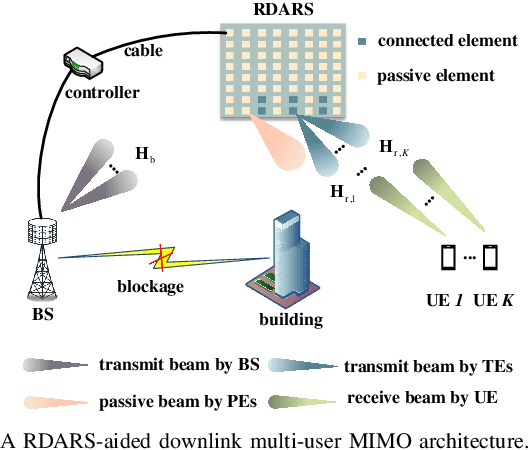
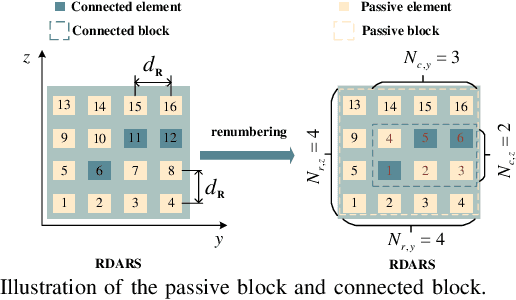

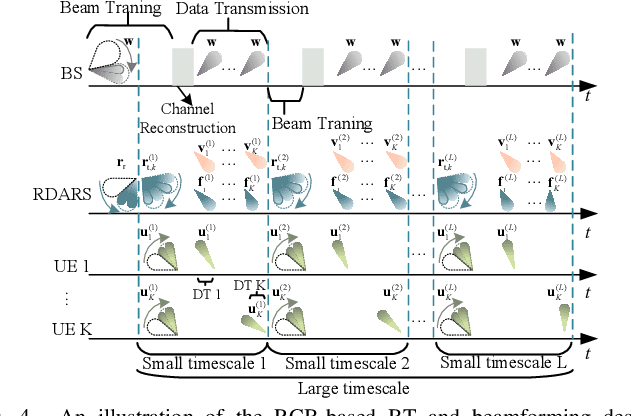
Abstract:Reconfigurable distributed antenna and reflecting surface (RDARS) is a new architecture for the sixth-generation (6G) millimeter wave (mmWave) communications. In RDARS-aided mmWave systems, the active and passive beamforming design and working mode configuration for reconfigurable elements are crucial for system performance. In this paper, we aim to maximize the weighted sum rate (WSR) in the RDARS-aided mmWave system. To take advantage of RDARS, we first design a reconfigurable codebook (RCB) in which the number and dimension of the codeword can be flexibly adjusted. Then, a low overhead beam training scheme based on hierarchical search is proposed. Accordingly, the active and passive beamforming for data transmission is designed to achieve the maximum WSR for both space-division multiple access (SDMA) and time-division multiple access (TDMA) schemes. For the TDMA scheme, the optimal number of RDARS transmit elements and the allocated power budget for WSR maximization are derived in closed form. Besides, the superiority of the RDARS is verified and the conditions under which RDARS outperforms RIS and DAS are given. For the SDMA scheme, we characterize the relationship between the number of RDARS connected elements and the user distribution, followed by the derivation of the optimal placement positions of the RDARS transmit elements. High-quality beamforming design solutions are derived to minimize the inter-user interference (IUI) at the base station and RDARS side respectively, which nearly leads to the maximal WSR. Finally, simulation results confirm our theoretical findings and the superiority of the proposed schemes.
Power Allocation for Coordinated Multi-Point Aided ISAC Systems
Mar 10, 2025Abstract:In this letter, we investigate a coordinated multiple point (CoMP)-aided integrated sensing and communication (ISAC) system that supports multiple users and targets. Multiple base stations (BSs) employ a coordinated power allocation strategy to serve their associated single-antenna communication users (CUs) while utilizing the echo signals for joint radar target (RT) detection. The probability of detection (PoD) of the CoMP-ISAC system is then proposed for assessing the sensing performance. To maximize the sum rate while ensuring the PoD for each RT and adhering to the total transmit power budget across all BSs, we introduce an efficient power allocation strategy. Finally, simulation results are provided to validate the analytical findings, demonstrating that the proposed power allocation scheme effectively enhances the sum rate while satisfying the sensing requirements.
Joint Size and Placement Optimization for IRS-Aided Communications with Active and Passive Elements
Feb 24, 2025



Abstract:Different types of intelligent reflecting surfaces (IRS) are exploited for assisting wireless communications. The joint use of passive IRS (PIRS) and active IRS (AIRS) emerges as a promising solution owing to their complementary advantages. They can be integrated into a single hybrid active-passive IRS (HIRS) or deployed in a distributed manner, which poses challenges in determining the IRS element allocation and placement for rate maximization. In this paper, we investigate the capacity of an IRS-aided wireless communication system with both active and passive elements. Specifically, we consider three deployment schemes: 1) base station (BS)-HIRS-user (BHU); 2) BS-AIRS-PIRS-user (BAPU); 3) BS-PIRS-AIRS-user (BPAU). Under the line-of-sight channel model, we formulate a rate maximization problem via a joint optimization of the IRS element allocation and placement. We first derive the optimized number of active and passive elements for BHU, BAPU, and BPAU schemes, respectively. Then, low-complexity HIRS/AIRS placement strategies are provided. To obtain more insights, we characterize the system capacity scaling orders for the three schemes with respect to the large total number of IRS elements, amplification power budget, and BS transmit power. Finally, simulation results are presented to validate our theoretical findings and show the performance difference among the BHU, BAPU, and BPAU schemes with the proposed joint design under various system setups.
Secure Communication in Dynamic RDARS-Driven Systems
Jan 18, 2025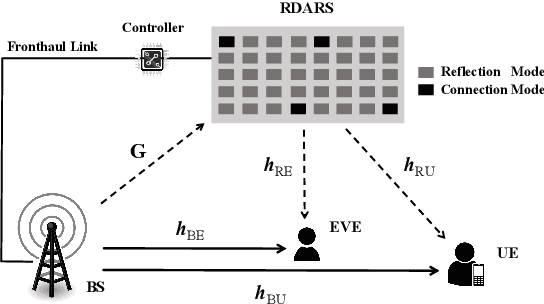
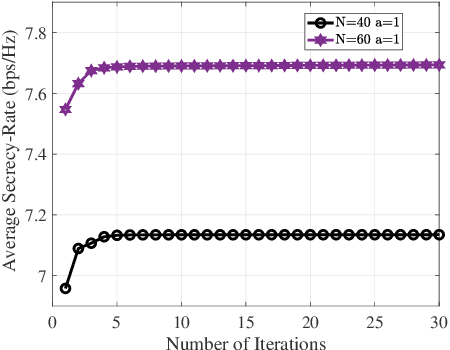

Abstract:In this letter, we investigate a dynamic reconfigurable distributed antenna and reflection surface (RDARS)-driven secure communication system, where the working mode of the RDARS can be flexibly configured. We aim to maximize the secrecy rate by jointly designing the active beamforming vectors, reflection coefficients, and the channel-aware mode selection matrix. To address the non-convex binary and cardinality constraints introduced by dynamic mode selection, we propose an efficient alternating optimization (AO) framework that employs penalty-based fractional programming (FP) and successive convex approximation (SCA) transformations. Simulation results demonstrate the potential of RDARS in enhancing the secrecy rate and show its superiority compared to existing reflection surface-based schemes.
Wireless Communication with Flexible Reflector: Joint Placement and Rotation Optimization for Coverage Enhancement
Dec 25, 2024



Abstract:Passive metal reflectors for communication enhancement have appealing advantages such as ultra low cost, zero energy expenditure, maintenance-free operation, long life span, and full compatibility with legacy wireless systems. To unleash the full potential of passive reflectors for wireless communications, this paper proposes a new passive reflector architecture, termed flexible reflector (FR), for enabling the flexible adjustment of beamforming direction via the FR placement and rotation optimization. We consider the multi-FR aided area coverage enhancement and aim to maximize the minimum expected receive power over all locations within the target coverage area, by jointly optimizing the placement positions and rotation angles of multiple FRs. To gain useful insights, the special case of movable reflector (MR) with fixed rotation is first studied to maximize the expected receive power at a target location, where the optimal single-MR placement positions for electrically large and small reflectors are derived in closed-form, respectively. It is shown that the reflector should be placed at the specular reflection point for electrically large reflector. While for area coverage enhancement, the optimal placement is obtained for the single-MR case and a sequential placement algorithm is proposed for the multi-MR case. Moreover, for the general case of FR, joint placement and rotation design is considered for the single-/multi-FR aided coverage enhancement, respectively. Numerical results are presented which demonstrate significant performance gains of FRs over various benchmark schemes under different practical setups in terms of receive power enhancement.
Multi-Functional Beamforming Design for Integrated Sensing, Communication, and Computation
Jul 01, 2024Abstract:Integrated sensing and communication (ISAC) systems may face a heavy computation burden since the sensory data needs to be further processed. This paper studies a novel system that integrates sensing, communication, and computation, aiming to provide services for different objectives efficiently. This system consists of a multi-antenna multi-functional base station (BS), an edge server, a target, and multiple singleantenna communication users. The BS needs to allocate the available resources to efficiently provide sensing, communication, and computation services. Due to the heavy service burden and limited power budget, the BS can partially offload the tasks to the nearby edge server instead of computing them locally. We consider the estimation of the target response matrix, a general problem in radar sensing, and utilize Cramer-Rao bound (CRB) as the corresponding performance metric. To tackle the non-convex optimization problem, we propose both semidefinite relaxation (SDR)-based alternating optimization and SDR-based successive convex approximation (SCA) algorithms to minimize the CRB of radar sensing while meeting the requirement of communication users and the need for task computing. Furthermore, we demonstrate that the optimal rankone solutions of both the alternating and SCA algorithms can be directly obtained via the solver or further constructed even when dealing with multiple functionalities. Simulation results show that the proposed algorithms can provide higher target estimation performance than state-of-the-art benchmarks while satisfying the communication and computation constraints.
 Add to Chrome
Add to Chrome Add to Firefox
Add to Firefox Add to Edge
Add to Edge